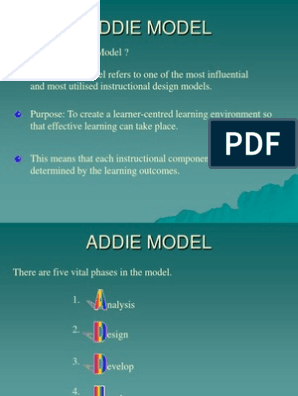0% found this document useful (0 votes)
23 views7 pagesPresentation of Discussion PDF
The document outlines the Instructional Planning Cycle, specifically the ADDIE model, which includes Analysis, Design, Development, Implementation, and Evaluation. It emphasizes the importance of understanding students' mother tongue and tailoring lessons to their unique needs. Each phase of the ADDIE model is described with examples of tasks and outputs to illustrate the instructional design process.
Uploaded by
Joseph HerreraCopyright
© © All Rights Reserved
We take content rights seriously. If you suspect this is your content, claim it here.
Available Formats
Download as PDF, TXT or read online on Scribd
0% found this document useful (0 votes)
23 views7 pagesPresentation of Discussion PDF
The document outlines the Instructional Planning Cycle, specifically the ADDIE model, which includes Analysis, Design, Development, Implementation, and Evaluation. It emphasizes the importance of understanding students' mother tongue and tailoring lessons to their unique needs. Each phase of the ADDIE model is described with examples of tasks and outputs to illustrate the instructional design process.
Uploaded by
Joseph HerreraCopyright
© © All Rights Reserved
We take content rights seriously. If you suspect this is your content, claim it here.
Available Formats
Download as PDF, TXT or read online on Scribd
/ 7































































































